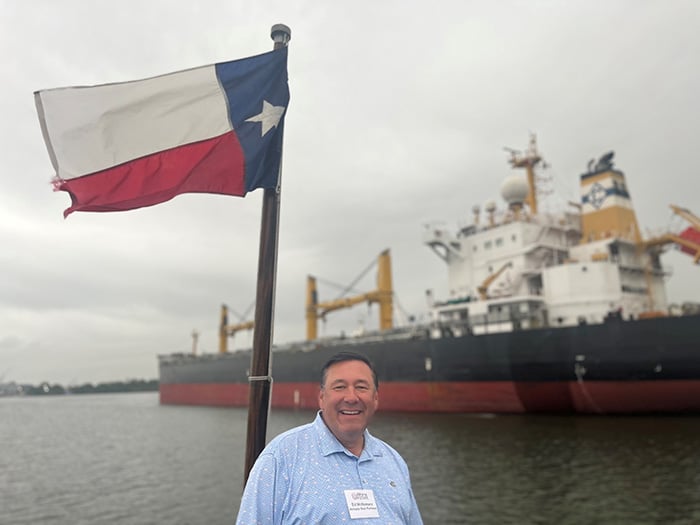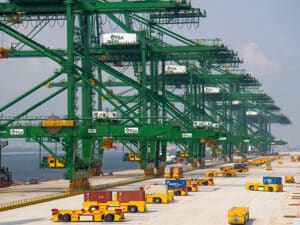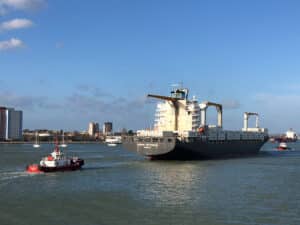
Op-Ed: Protecting a port or shipyard with the right insurance
Written by
Armada Risk Partners CEO Ed McNamara, Cleveland Ohio port insurance broker
By Ed McNamara CEO Armada Risk Partners
Ports, terminal and shipyard operators need to be especially vigilant and aware of how they should protect themselves in the event of collisions between vessels at port, as well as accidental damage to infrastructure with the right insurance.
Ships colliding with each other in and around ports and with port infrastructure itself are common and can inflict huge costs and disruption. One recent case in July 2022 saw the bulk carrier Bunun Queen, transiting eastbound in the Gulf of Mexico colliding with an offshore supply vessel Thunder, damage to both vessels was estimated at $12.3 million. Meanwhile excessive speed led to a tugboat collision with a containership in the Houston Ship Channel last year. The vessels involved were the tugboat George M and the containership MSC Aquarius and Whileno injuries were reported about 1,000 gallons of gear oil were released from the damaged George M’s port propulsion unit. Damages to both vessels totaled more than $900,000.
Collisions can also cause authorities like the U.S. Coast Guard to close port access during the clean up phase for an indefinite period causing huge disruption and potential loss of income to port operators.
Shipyards, meanwhile, are especially vulnerable to accidents and disruption. In 2019, damage to a drydock facility at the Grand Bahama Shipyard proved very expensive for the cruise industry. The damaged drydock, the largest of three at Grand Bahama, was put out of commission when a crane collapsed while raising the stern of the Oasis of the Seas. The accident forced Royal Caribbean Cruises Ltd. (RCCL) to take the Oasis to a yard in Europe to finish repairing it. The repairs, plus the cost of three canceled Oasis cruises, caused an estimated $52 million from RCCL’s 2019 earnings.
Work with specialists who understands your business
It’s advised that ports and shipyards take a careful approach to insurance so they can present the most robust case to a prospective insurer.
We advise taking a methodical approach working with someone who is a specialist in marine and who knows your port and shipyard operations in detail. Every port and shipyard is different so you have to approach an insurer with a customized case for port collision and accident damage if you are to secure the most comprehensive coverage at the best price.
Horizon scan risk
The starting point is to review the insurance cover you have in place and undertake a thorough risk assessment within your port or shipyard specifically relating to collisions and accidents. Use all the data you have on incidents to assess the likelihood and severity of accidents and where you are weak. You need to show the insurer that you understand the principle that the best crisis management is never heard about because you have prevented it ever happening by horizon scanning and de-risking your areas of weakness.
Customize your policy
When selecting your coverage make sure you customize the insurance policy to specifically address your risk profile. These policies should consider the port’s size, number of vessel movements, location and how congested your port and waterways are, the cargo types and how potentially dangerous they are. A cautionary tale is the tragic Port of Beirut explosion in August 2020 when a large amount of ammonium nitrate stored at the port exploded devastating the city causing 200 deaths and 6,500 injuries doing $15 billion of damage. This was dreadfully sad and one of the worst industrial accidents in modern times. And while an extreme example this catastrophe could have been prevented by a thorough examination of the risks of cargo at the port and taking action to better safeguard or dispense entirely with the material.
Count on yourself; not third party insurance
In terms of collisions in ports we advise that the insurance policy covers not only damage to port infrastructure but also collision damage to ships and any third-party liability that may arise from accidents within the port area. You must ensure your port is covered for all eventualities. You do not want to be at the mercy of a third party to cover the clean up or repair costs when they may or may not have adequate insurance. We frequently see that third parties cannot be relied upon to act in your best interests in the event of an accident. If you have comprehensive insurance you can prioritize finding the funds to pay for any clean up and further protect yourself from third party claims.
Embrace training and technology
A smart move is to embrace technology when looking to mitigate risk. Examine improved navigation aids, surveillance systems, and review and refresh safety protocols. Extend safety training for port personnel and practice your emergency response showing what you have done and what you have learned. As well as being a very useful training exercise, insurers may offer discounts for ports with strong documented risk management practices.
Be wary of badly worded tenant and supplier policies
In addition, evidence of regular risk reviews shows insurers you are evolving with the dynamic operations of your port so your coverage can keep pace. As part of this process look at the proper legal wording when sourcing insurance so it doesn’t hurt your ability to respond.. This is especially important when reviewing and signing contracts with new or existing suppliers and third parties operating at your facilities. Often responsibility for collisions and accidents is vague and badly worded, make sure you are clear on who carries legal responsibility in all accident scenarios.
Keep a war chest
On the financial side we advise setting up a “war chest” for insurance premiums and claims deductibles. It is wise to consider having a rainy day fund for unexpected events to ensure financial stability in case of major incidents.
Review often
Finally, we advise checking the channels of communication with your insurance broker so they are keeping themselves aware of new or emerging risks in your operations. They should also be able to feed you useful intelligence about industry trends and insurance market conditions. It is worth reinforcing the point that your aim should be to protect yourself by seeing crises in advance and preventing them, while at the same time keeping your financial losses and premium to a minimum.




